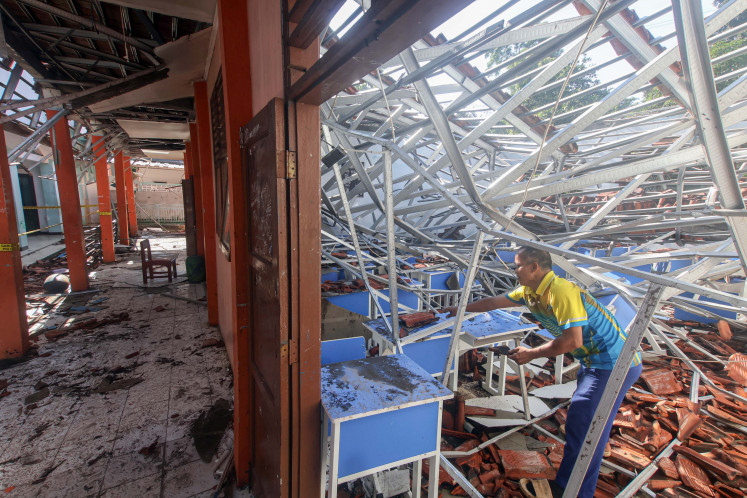Popular Reads
Top Results
Can't find what you're looking for?
View all search resultsPopular Reads
Top Results
Can't find what you're looking for?
View all search resultsBeyond statistics of poverty
The issue of poverty has recently been brought to the public’s attention
Change text size
Gift Premium Articles
to Anyone
T
he issue of poverty has recently been brought to the public’s attention. In addition, the UN’s International Fund for Agricultural Development has warned that with the earth’s population set to reach nine billion by 2050, there is a real threat of massive food shortages and poverty in developing countries.
The picture of Indonesian development reveals many families are not benefiting from national economic growth. Fifty percent of Indonesia’s population is still poor, hovering around the poverty line, living on less than US$2 per day. Also, concerns have arisen as data on poverty status exist. If this continues, it will create unpredictable progress in terms of the country’s prosperity in the future.
The Center for Welfare Studies reported that the number of poor people in Indonesia increased by 6.7 percent over the last three years to 43.1 million. The report showed the number of Indonesians living in extreme poverty was 40.36 million in 2008, 44.83 million in 2009, and 43.07 million in 2010. In 2011, Indonesia experienced a decline in poverty rates from 12.49 percent in March, but it decreased to 12.36 percent in September.
Some islands have different poverty percentages. For example, Maluku and Papua had the largest percentage of its people in poverty, at 25 percent, while Kalimantan had the lowest at 7 percent. Java is the island that hosted the poorest Indonesians, at 16.74 million people, while the major island with the smallest number of poor was Kalimantan, with 97,000 people.
The Asian Development Bank (ADB), however, said not all the statistics in the paper were directly comparable, as they were based on different sources and methodologies.
For example, the 2008 data was based on the Indonesian government’s National Socio-Economic Survey; the 2009 data was collected from the World Bank’s PovcalNet database, whereas the 2010 data was taken from an economic modeling method assuming poverty rates change relative to a country’s Gross Domestic Product (GDP).
The government also has different methodologies of creating poverty data. According to the Central Statistics Agency (BPS), the number of Indonesia’s poor is at 30.2 million, which is much lower than the ADB’s 43.12 million.
In this case, the ADB marks the country’s poverty line at an earning level of $1.25 per day, while the government has set it at $1.13. If the poverty line was set at $2 per day as suggested by the ADB, the statistic for the number of poor here would further increase to reach at least 117 million, or about 50.57 percent of the population.
In 2011, the BPS reported that the number of poor people was only 12 percent of the population. In this case, the poverty line used was the monthly per capita earnings of Rp 243,729 ($26.80) in September and Rp 233,740 in March. The use of different values of poverty lines to count the poor has caused confusion for common audiences.
Data from the last six years shows a decline in the number of low income people from 17.75 percent in 2006, 16.58 percent in 2007, 15.42 percent in 2008, 14.15 percent in 2009, 13.3 percent in 2010 and 12.49 percent in 2011. However, this trend has not proved that the poor population in Indonesia has significantly declined.
In reality, using the income and the poverty line to measure poverty still does not picture poverty reduction. As reported by ADB, Indonesia is the only country in Southeast Asia in which poverty is on the rise. It is upsetting since Laos and Cambodia have few natural resources and inattentive governments.
Cambodia reduced poverty from 4.1 million people in 2009 to 4.09 million in 2011. Laos cut poverty from 2.18 million in 2009 to 2.04 million in 2011.
H. Ritonga, director for social resilience statistics at the BPS, said that although the number of poor was declining, poverty wasn’t significantly reduced. This is due to the fact that Indonesia is in a situation of chronic hardcore poverty. In this condition, the rich obtain most benefit from the economy’s rapid growth, while the poor, without sufficient access to capital, become relatively poorer.
In fact, eradicating poverty is more difficult for areas that have limited access to government’s facilities and services.
These facts illustrate that measuring poverty is complex. Observing poverty through income alone is extremely inadequate. Income information does not inform of the dynamics of life expenses and the feeling of financial security. Poverty should be seen as a situation filled with various deprivations due to a lack of empowerment and command over resources.
The national practice, using monthly per capita earnings of Rp 243,729 ($26.80) or $1.13 per day and the international practice by income of $1.25 or $2 per day to count the poor are inadequate. That calculation does not reflect their command over resources to achieve basic capabilities. These numbers are purely arbitrary. We cannot tell whether a person can meet all his basic needs with that amount of money. Basic need expenses vary from country to country.
Poverty is not just about statistics — it’s a human factor. According to the UN, poverty is a condition resulting from severe deprivation of basic human needs such as food, shelter, safe drinking water, sanitation, health, education and information. Poverty is the process of human development having several dimensions to assess.
According to Amartya Sen (Nobel Prize Winner, 1998), poverty is characterized by three factors that show lack of access to basic capabilities. They include a lack of being well nourished and healthy, as expressed by the proportion of underweight children under five; the lack of capability for healthy reproduction, as indicated by the proportion of births unattended by trained personnel and the lack of a capability to be educated and knowledgeable, as determined by the level of female illiteracy.
The World Bank reported that Indonesia had 75 percent of low income workers in the informal sector; more than 60 percent of poor families depending on income from agriculture; 55 percent of poor with limited primary education and 16 percent being illiterate; 50 percent of the poor with lack of access to clean water; 75 percent with access to inadequate sanitation; 25 percent of malnourished children under five, and a lack of adequate economic infrastructure such as reliable rural roads and efficient ports, which constrain growth for agriculture and agribusiness.
By 2015, 45 percent of poor households will be located in city slums. These composite poverty variables have been devised to give better indications of poverty. In this data, basic human needs are considered and quantified to show the level of poverty status.
It is clear that various poverty indices reveal different pictures of socioeconomic and cultural human realities. Poverty needs to be correctly measured to provide basic references for government policies.
Although none of the composite indexes (i.e. poverty line, poverty rate and income) are without criticism, they are still useful to underscore the fact that poverty is multidimensional. These indexes can also help to identify the deficit areas in the development of the society as well as the country.
Poverty extends beyond low incomes and the capability to have basic needs. It closely represents a life situation of a person that has limited choices and opportunities. Reducing poverty in Indonesia is not about having limited resources, but it is more about having pro-poor policies and effective institutions.
Therefore, all efforts towards poverty alleviation should focus on “empowering” the poor. However, these efforts still face challenges such as the country’s size and diversity, political system, job opportunities, access to primary education, bureaucratic inefficiency and corruption.
The writer is a professor at Murray State University, Kentucky.










